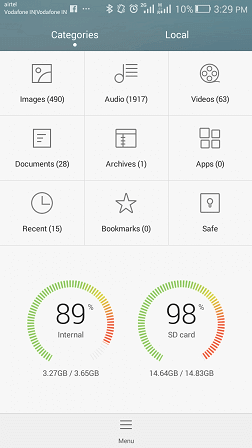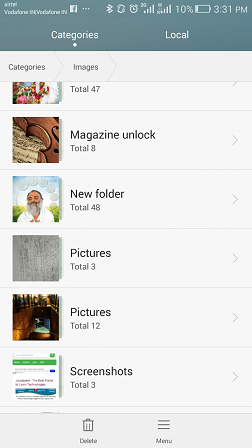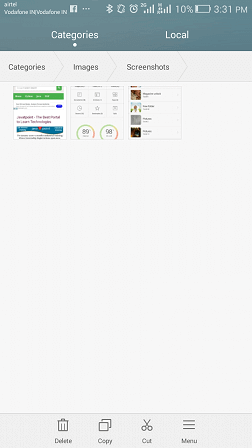Android Tutorial
Android Widgets
- UI Widgets
- Android Button
- Android Toast
- Android Custom Toast
- Android ToggleButton
- Android CheckBox
- Android Custom CheckBox
- Android RadioButton
- Android Dynamic RadioButton
- Custom RadioButton
- AlertDialog
- Spinner
- Auto Complete Text View
- ListView
- Custom ListView
- RatingBar
- WebView
- SeekBar
- DatePicker
- TimePicker
- Analog clock and Digital clock
- ProgressBar
- ScrollView Vertical
- HorizontalScrollView
- Image Switcher
- Image Slider
- ViewStub
- TabLayout
- TabLayout with FrameLayout
- SearchView
- SearchView on ToolBar
- EditText with TextWatcher
Activity and Intents
Android Fragments
Android Menu
Android Service
Android AlarmManager
Android Storage
Android SQLite
XML and JSON
Android Multimedia
Android Speech
Android Telephony
Android Device
Camera Tutorial
Sensor Tutorial
Android Graphics
Android Animation
Android Web Service
Android Examples
- QR Code / Bar Code Scanner
- RSS Feed Reader
- Volley Library Fetching JSON Data from URL
- Linkify Example
- Introduction Slider (Launch very first time when app start)
- RecyclerView List
- Swipe to Delete RecyclerView items with UNDU
- Swipe to refresh Android Activity
- Volley Library - Registration, Log-in, and Log-out
- Network Connectivity Services
- Firebase Authentication - Google Login
- Android Notification
- Using Google reCAPTCHA in Android Application
Android Social
Android Versions
Android Misc
- Android Device Manager
- Android Studio
- Android Auto
- Android to Mac
- Android Messages
- Android TV
- Android Screenshot
- Android Pay
- Android Watch
- Android Phones
- Android Tablet
- Android Find My Phone
- Android One
- Android Wear OS
- Android Data Recovery
- Android Antivirus
- Android x86
- Android Emulator for PC
- Android File Manager
- Android ad blocker
- Android Podcast App
- Fortnite Android an Epic Game
- FaceTime on Android
- ShowBox for Android
- Android App Store
- Virus Removal for Android
- cache in Android
- Root Android Device
- Android Screen Recorder
- block a number
- Canon printer app
- Wireless HP printer app
- How to Update Android
- iMessage for Android
- iCloud for Android
- Best Call Recorder
- Videoder Android
- YouTube Video Downloader
- Airdrop for Android
- RoboKiller for Android
- Clean my Android Phone
- How to hide apps, files, and photos on Android
- Best weather apps with widgets for Android
- Android File Transfer for Mac
- Mobdro for Android
- Screen Mirroring in Android
- Stock market apps for Android
- How to turn On or Off safe mode on Android
- Best browsers for Android
- Best clocks for Android
- Best email apps for Android
- Music player for Android
- Android smartwatch for women
- Best keyboard for Android
- Best messaging app for Android
Android MCQ
Android Interview
Android Quiz
Android Screenshot
Sometimes you need to take a screenshot of your Android mobile phone. Every Android mobile phone has different features, even though Android 4 introduced the simple screenshots for all with power-and-volume-down-key together. Some phones have introduced new methods.
In this tutorial, you will learn the various ways to snap, share, and save a screenshot.
Google phones
- Pixels: Hold down the power and volume-down buttons at the same time for a couple of seconds.
- Nexus: Hold down the power and volume-down buttons at the same time for a couple of seconds.
HTC phones
- HTC U12+: Hold the power button until the phone vibrates, and then tap the virtual home button on the navigation bar while still pressing the power button.
- HTC U series (up to U12+): Hold the power and volume-down buttons for a couple of seconds.
- HTC 10: hold down the power and volume-down buttons for a few seconds or hold down the home and power buttons.
- Other HTC phones: hold down the power and volume-down buttons for a couple of seconds.
Samsung phones
- Galaxy S8 and later: Hold the power and volume-down buttons for a couple of seconds.
- Galaxy S7 and earlier: Hold the home and power buttons for a couple of seconds.
Acer phones
- Hold power and volume-down buttons together for a couple of seconds.
- Slide the notification panel and go to a quick setting then tap the Screenshot icon.
Asus phones
- Hold power and volume-down buttons together for a couple of seconds.
- Slide the notification panel and go to a quick setting and tap the Screenshot icon.
Motorola phones
- Hold power and volume-down buttons together for a couple of seconds.
OnePlus phones
- OnePlus 5, 5T, and 6: Swipe down the three fingers on the home screen.
- All OnePlus phones: Hold the power and volume-down buttons for a couple of seconds.
Huawei and Honor phones
- Hold power and volume-down buttons together for a couple of seconds.
- Slide the notification panel, go to Shortcuts, and tap the Screenshot icon.
Lenovo
- Hold power and volume-down buttons together for a couple of seconds.
- Swipe down the notification panel and tap the Screenshot icon.
LG phones
- LG G7: Hold the power and volume-down buttons together for a couple of seconds.
- Other LG phones: Swipe down the notification panel and tap the Captute+ icon.
Sony phones
- Hold power and volume-down buttons together for a couple of seconds.
- Hold the power key until a screen appears and click on that screenshot.
ZTE phones
Hold power and volume-down buttons together for a couple of seconds.



Save and share
Once you snapped the screenshot, you can create a shortcut to it in the notification panel. Tap on it, and you will be able to edit or share it.
If you are running Android 2.3 and below
The Android 2.3 and below versions phones do not have built-in screenshot functionality. However, some devices (many Samsung phones) have these features, but vary phone to phone.
If your phone doesn't have a built-in screenshot, you need to use a third-party application like No Root Screenshot It. Install this app on your phone and install its free companion app on your computer. This will enable screenshots.


